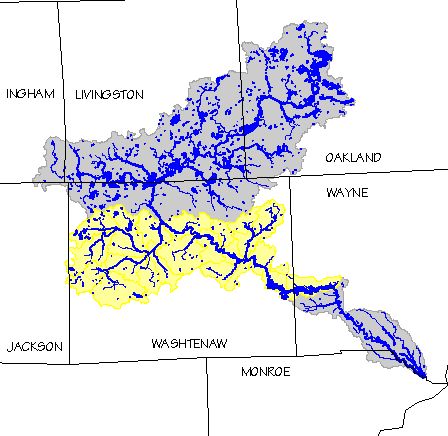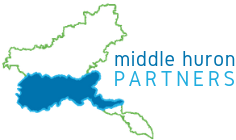The Middle Huron
 The Middle Huron is generally defined as the section of the Huron River that moves through Washtenaw County. It begins with the Mill Creek basin in western Washtenaw County and extends downstream through Belleville Lake in western Wayne County. The Middle Huron is home to over half the population of the Huron River Watershed, has the largest areas of active agriculture in the Watershed, and contains the most urbanized areas of the Watershed. This concentration of people, agriculture and industry presents challenges to the quality of the waters in the Middle Huron. For additional information on the geography and water quality of the Middle Huron, visit our Infostream.
The Middle Huron is generally defined as the section of the Huron River that moves through Washtenaw County. It begins with the Mill Creek basin in western Washtenaw County and extends downstream through Belleville Lake in western Wayne County. The Middle Huron is home to over half the population of the Huron River Watershed, has the largest areas of active agriculture in the Watershed, and contains the most urbanized areas of the Watershed. This concentration of people, agriculture and industry presents challenges to the quality of the waters in the Middle Huron. For additional information on the geography and water quality of the Middle Huron, visit our Infostream.
The Huron Main Branch, and several tributaries within the Middle Huron River Watershed, have had watershed management and restoration plans developed by the Huron River Watershed Council.
- The Middle Huron River Watershed Management Plan, Section 2 (2020). Includes: The Huron River from Barton Pond to the Confluence of Fleming Creek, Associated Tributaries, Fleming Creekshed, Allens Creekshed, Malletts Creekshed, Millers Creekshed, Swift Run Creekshed, Traver Creekshed
- The Middle Huron (2011; this plan is currently being updated by splitting it into the 3 sections mentioned on this page).
- Mill Creek Subwatershed Plan (2006).
Currently, HRWC is working on:
- The Middle Huron River, Section 1 (anticipated 2022). Includes: The Huron River from Flook Dam (Portage Lake) to Barton Pond, Associated Tributaries, Mill Creekshed, Boyden Creekshed, Honey Creekshed (South).
- The Middle Huron River, Section 3 (anticipated 2023). Includes: The Huron River from the Confluence of Fleming Creek to French Landing Dam (Belleville Lake), Associated Tributaries, Ford Lake, and Belleville Lake.
Formation of the Middle Huron Partners

After a series of annual harmful algal blooms in Ford and Belleville Lakes in the 90s, the Middle Huron Partners (originally the Middle Huron Initiative) began in 1996 as a coordinated response to implement Michigan’s first nutrient Total Maximum Daily Load (TMDL). In 1999, the Michigan Department of Environmental Quality, HRWC, and municipalities signed a cooperative agreement to reduce phosphorus loadings by 50% in order to meet the TMDLs for Ford and Belleville Lakes. Facilitated by HRWC, the Middle Huron Partners brings together municipalities, universities, and county agencies to collaboratively develop and implement strategies to reduce phosphorus loadings, share stormwater best management practices, and improve the quality of the Middle Huron River Watershed.
In general, the Partnership aims to:
- Improve monitoring and modeling for nutrient sources (both phosphorus and nitrogen), which act as pollutants;
- Support increased research and monitoring;
- Support watershed education and planning;
- Assist landowners and local governments to engage in practices to reduce the amount of phosphorus, and other pollutants, entering the river;
- Upgrade sewage and wastewater treatment facilities and improve their operation; and
- Provide a source of support to test innovative ideas to reduce phosphorus pollution.
Participating Partners
Partners to the program (see list below) voluntarily provide financial support for HRWC to facilitate the Partnership. Implementation projects in the Middle Huron are funded by federal Clean Water Act grants, Clean Michigan Initiative grants, private foundations, individual donations, and business partnerships.
Current financial supporters of the Middle Huron Partners include:
- Ann Arbor Charter Township
- Ann Arbor Public Schools
- City of Ann Arbor
- City of Belleville
- City of Chelsea
- City of Dexter
- City of Ypsilanti
- Eastern Michigan University
- Pittsfield Charter Township
- Scio Township
- Superior Township
- University of Michigan – Environment, Health & Safety
- VA Ann Arbor Healthcare System
- Village of Barton Hills
- Washtenaw County Road Commission
- Washtenaw County Water Resources Commissioner
- Ypsilanti Charter Township
Accomplishments
Since its formation, the Middle Huron has seen dramatic and substantial decreased in phosphorus levels throughout the watershed thanks to the leadership by the Partners. Participating organizations and communities have adopted numerous river-friendly ordinances and have raised the level of water quality protection in their standards and codes. In addition, the Middle Huron Partners initiated the ongoing statewide discussions on the development of state legislation to restrict the application of manufactured phosphorus fertilizers. In 2012, the legislation took effect at the state level. The Middle Huron Partners have also worked with local farmers to adopt conservation practices on more than 2,600 acres in the Middle Huron. Over $200,000 of USDA funds have been supplied to farmers for the installation of best management practices on their Mill Creek sub-watershed farms.
More Information
For additional information on the work of the Middle Huron Partners, please contact Andrea Paine at apaine@hrwc.org.



